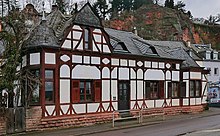Trier tram
| Trier tram | |
|---|---|
| A 1918 tram on the Trier main market. | |
| Basic information | |
| Country | Germany |
| city | trier |
| opening | July 27, 1890 |
| Shutdown | September 14, 1951 |
| Infrastructure | |
| Route length | 20 km |
| Gauge | 1000 mm ( meter gauge ) |
| Depots | 1 |
| business | |
| Lines | 4th |
The Trier tram existed from 1890 to 1951.
history
The history of the tram in Trier began in 1874. At that time, several companies applied to set up a horse-drawn tram in the city . In 1889, the engineer Charles de Féral from Brussels was commissioned to build a horse-drawn railway. However, his application to be allowed to operate them electrically was rejected.
On July 27, 1890, the meter-gauge horse - drawn tram began operating in Trier. There were initially two routes. One led from the main train station past the Porta Nigra over the main market to the south train station. The second route branched off from the first at the Hauptmarkt and led to today's Römerbrücke , which at that time was still called the "Moselle Bridge". In 1902 the railway became the property of the city. Against the resistance of the population, who feared that the historic cityscape would be defaced, the horse-drawn tram was switched to electrical operation in 1905.
Immediately after the changeover, the route network was enlarged and expanded. The first line was extended from the Römerbrücke to Eurener Straße and two more routes were opened from the Römerbrücke via Pallien and Aufgang Weißhaus past the Porta Nigra to the cemetery and from the main market to St. Matthias in 1906. In 1913 the network was extended from Eurener Strasse to Euren and from Porta Nigra to the new Kaiser Wilhelm Bridge. At the end of 1913, the total length of all routes was 11.5 kilometers.
A total of four lines were operated, which were marked between 1913 and 1931 with a red triangle, a blue disc, a green square and a white cross. From January 20, 1940, the city began to replace the tram with trolleybuses . Due to the war interrupted the changeover. Since September 14, 1951, the tram operation in the city of Trier has been stopped. The operation of the Trier trolleybus ended on May 27, 1970.

Today, some overexposed rails, which, among other things, keep coming to light during road construction work, testify to the tram. In Jüdemerstraße , in particular, rails are permanently visible from the ailing asphalt. There are also overhead line rosettes at various houses along the former tram routes . In Pallien, the bus shelter at the terminus is still preserved, which serves as an apartment.
Since the 1990s, a renaissance of the tram in Trier has been discussed again and again, especially in the form of a separate public transport route to better connect the Petrisberg and the university . In 2012, however, the idea was discarded for cost reasons, but should nevertheless be considered as a long-term alternative.
vehicles
The horse-drawn tram was initially 15, later 18 carriages, half of which were closed (carriage 1-9) and the other half were open summer carriages (10-18). The closed wagons were mainly used in winter, but also in summer if necessary. After the horse-drawn tram operation was closed, all cars were handed over to the Riegelsberg tram in 1905.
In 1905, 24 railcars with open platforms were built by the Busch wagon factory in Bautzen for the electric tram . In addition, a short work railcar, also with open platforms, with the company no. 101 added. The remaining cars were given the company number. 1-24. Initially, all of the wagons had Lyrabügel , later these were replaced by pantographs . Initially they were labeled “Trier's trams”, later shortened to “City of Trier”.
In 1910, the fronts of 18 of the 24 railcars were changed by installing a central headlight. The previously characteristic bead also disappeared. The passenger compartment had three side windows each. From the 1930s onwards, the middle large window was divided in the middle. There were also open summer cars in traffic, but these were scrapped after the First World War. A vehicle came to Chemnitz in 1941 .
In 1927/28 twelve more railcars were purchased from Van Zypen & Charlier, which were given the road numbers 25-36. The cars from 1927 were electrically equipped by SSW, the cars from 1928 by AEG. After the first trolleybuses went into operation, all the sidecars that were still in existence gradually came to Chemnitz, Bingen and a Berlin scrap dealer. Six of the surplus railcars were sold to Metz and one to Dessau. All other cars were parked after the cessation of operations in 1951 and then scrapped.
The vehicles for the trolleybus operation were purchased from MAN in 1940 with electrical equipment from BBC. In the following year, they were followed by five more trolleybuses with three trailers.
literature
- D. Höltge: German trams and light rail vehicles. Volume 4: Rhineland-Palatinate / Saarland. Verlag Zeunert, Gifhorn 1981, ISBN 3-921237-60-2 , pp. 206-217.
- Joachim Gilles, Karl-Joseph Gilles: The Trier trams . Sutton Verlag, 2011, ISBN 978-3-89702-944-6 .
- Joachim Gilles, Karl-Joseph Gilles: By tram and trolleybus through Trier. 1935 to 1970 . Sutton Verlag, 2007, ISBN 978-3-86680-223-0 .
- M. Kochems, D. Höltge: Trams and light rail vehicles in Germany. Volume 12: Rhineland-Palatinate / Saarland. EK-Verlag, Freiburg 2011, ISBN 978-3-88255-393-2 , pp. 254-269
Web links
Individual evidence
- ↑ editorial: A tram for Trier? - Lokalo.de. In: Lokalo.de. March 11, 2015, accessed November 8, 2016 .
